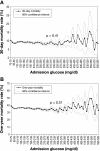An overview of glycemic control in the coronary care unit with recommendations for clinical management
- PMID: 20144388
- PMCID: PMC2787034
- DOI: 10.1177/193229680900300614
An overview of glycemic control in the coronary care unit with recommendations for clinical management
Abstract
The observation that elevated glucose occurs frequently in the setting of acute myocardial infarction was made decades ago. Since then numerous studies have documented that hyperglycemia is a powerful risk factor for increased mortality and in-hospital complications in patients with acute coronary syndromes. While some questions in this field have been answered in prior investigations, many critical gaps in knowledge continue to exist and remain subjects of intense debate. This review summarizes what is known about the relationship between hyperglycemia, glucose control, and outcomes in critically ill patients with acute coronary syndromes, addresses the gaps in knowledge and controversies, and offers general recommendations regarding glucose management in the coronary care unit.
Figures




References
-
- Datey K, Nanda N. Hyperglycemia after acute myocardial infarction: its relation to diabetes mellitus. N Engl J Med. 1967;276(5):262–265. - PubMed
-
- Kosiborod M, Rathore SS, Inzucchi SE, Masoudi FA, Wang Y, Havranek EP, Krumholz HM. Admission glucose and mortality in elderly patients hospitalized with acute myocardial infarction: implications for patients with and without recognized diabetes. Circulation. 2005;111(23):3078–3086. - PubMed
-
- Bellodi G, Manicardi V, Malavasi V, Veneri L, Bernini G, Bossini P, Distefano S, Magnanini G, Muratori L, Rossi G, et al. Hyperglycemia and prognosis of acute myocardial infarction in patients without diabetes mellitus. Am J Cardiol. 1989;64(14):885–888. - PubMed
-
- Capes SE, Hunt D, Malmberg K, Gerstein HC. Stress hyper-glycaemia and increased risk of death after myocardial infarction in patients with and without diabetes: a systematic overview. Lancet. 2000;355(9206):773–778. - PubMed
Publication types
MeSH terms
Substances
LinkOut - more resources
Full Text Sources
Medical

